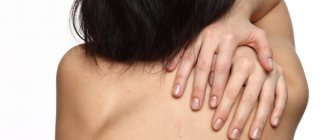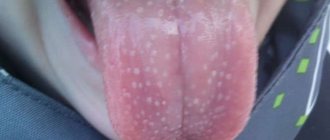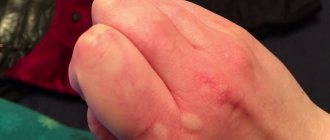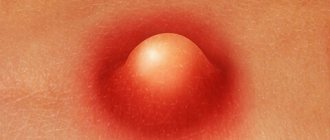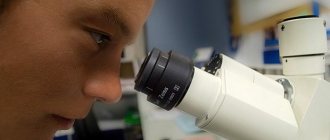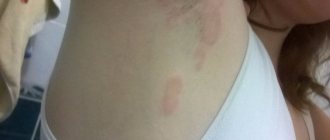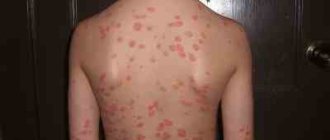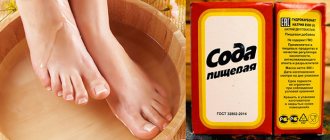Fungus on the toes is a mycosis that manifests itself as peeling skin, discomfort, and an unpleasant odor. With onychomycosis (nail fungus), the nail plate is destroyed. Diseases can be transmitted from a sick person to a healthy person, so precautions must be taken. Pathogenic microorganisms accumulate on the surface of the skin, which provoke the development of the disease. Toe fungus can be eliminated through proper and timely treatment.
Reasons for appearance
A fungus on the skin of the big toe can be picked up in public places (baths, saunas, swimming pools, water parks and other institutions where people walk without shoes). It should be noted that fungal spores often land on people’s skin, but not everyone becomes infected. For infection to occur, the microorganism needs to enter the skin cells, gain a foothold there and begin to multiply. This is facilitated by wounds and microcracks. We may not see them, but for the fungus they are wide open doors.
It is also possible to become infected if one of the family members is already sick with mycosis. This occurs if people do not follow the rules of personal hygiene, use a common towel, sleep in the same bed, or share shoes and socks.
The threat of fungal infection in public places is reduced if a person has a strong immune system.
Mycosis on the big toe nail can also appear after trying on shoes in stores or at the market, if done on bare feet.
Other factors that contribute to fungal infection:
- Lack of foot hygiene.
- Increased sweating (sweat is an excellent breeding ground for fungi).
- Flat feet.
- Wearing tight shoes.
- Old age (over the years, people's blood circulation becomes impaired and their immunity weakens).
- Performing a pedicure with instruments that have not been disinfected.
More often, the fungus first appears on the skin of the thumb, since it is easier for it to develop in the soft layers of the dermis. If the disease is not treated, it spreads to the nails. However, in some cases, onychomycosis is a primary disease, and microorganisms spread from the affected nail plate to the skin.
Causes of the disease
There are several factors that can cause your big toes to become infected with fungus. As a rule, a person becomes infected when pathogenic spores come into contact with the skin through contact with the surfaces of objects that already have bacteria on them in public places. Infection also occurs when using someone else's towels, bath accessories, slippers (other shoes). The risk of contracting onychomycosis of the thumbnail increases with the following factors:
- presence of flat feet;
- excessive sweating of the feet;
- damage to the nail plate or the skin next to it (this makes it easier for the infection to penetrate the body);
- poor foot hygiene;
- presence of diaper rash;
- immunosuppression;
- wearing tight/poor quality shoes.
Signs
Microorganisms that infect the nail plate secrete enzymes that promote its destruction. In this way, the fungus prepares space for its own reproduction and colony growth. Signs depend on the stage of the disease.
Mycosis of the skin manifests itself in severe itching. This is the very first sign. Next, a bubble appears filled with light exudate. The bubble bursts, and in its place a deep crack forms. It is extremely painful; it even hurts for a person to walk in shoes. In addition, the wound continues to itch. Dry, flaky skin forms around it. The crack may heal, but soon reappear.
At first, the disease does not manifest itself in any way on the nail plate. You can suspect from individual whitish spots and stripes that there is a nail fungus on the big toe. The photo above shows what the affected area looks like.
At the second stage, the nail becomes dull (sometimes turns yellow), thickens significantly and becomes curved. It can often grow into the skin, causing pain when walking and local inflammation.
At the third stage of onychomycosis, the nail becomes loose and painful to trim. In some patients it may peel off from the skin. At this stage, the patient poses a significant threat to others, since his nail plate becomes a container for fungal spores, which are easily dispersed over surfaces.
Stages of fungal infection and their symptoms
Onychomycosis can occur as a result of human infection with different types of fungi. The disease is not fatal, but its danger is that the fungus can spread from the big toe to neighboring nails, hands, and spread to the armpit and groin area. Moreover, at first the person does not even notice the changes, but then the nails begin to change color, becoming yellow or brownish. Due to the compaction of the structure of the nail plates, wearing shoes begins to cause discomfort and pain. Doctors divide the development of onychomycosis into 3 stages:
- Initial stage. Barely noticeable spots or stripes appear on the big toe nail. In general, the feet look quite healthy.
- Second stage. The affected nail begins to lose its shine, the color becomes deep yellow, and the feet smell unpleasant.
- Launched form. The nail plates move away from the skin, have a loose structure, and sometimes even fall off on their own. At this stage, there is a huge risk of infecting loved ones, since spores actively spread (scatter) in the bathroom and on the floor of the home.
Classification
Onychomycosis has three stages:
By the color of the nail you can figure out which fungus has occupied it:
Symptoms, types
Interdigital mycosis has several stages of development, each of which has specific manifestations.
- the appearance of small cracks between the fingers, especially under the little toe, as well as on the feet;
- slight peeling of the skin in the area where cracks form.
The next stage of development of interdigital mycosis is characterized by more pronounced symptoms. Red spots appear on the skin, peeling is already pronounced. At this time, bubble formations with clear liquid may occur.
During the second stage of development of the disease, corns begin to form, the skin becomes rough, and calluses appear. At this time, peeling is accompanied by itching and sometimes burning.
Fungus on the little toe
The penultimate stage of the fungus between the fingers is characterized by a worsening of the condition of the affected skin. The cracks become deeper, turning into erosions. Wet fungus develops. Along with these symptoms, other signs appear: inflammation and swelling of the areas affected by the fungus.
In advanced forms of the disease, symptoms are observed:
- the appearance of purulent blisters between the fingers, under the little toe and on the feet;
- soreness and itching increase;
- redness and irritation of the skin are pronounced.
Treatment
The success of treatment for toenail fungus depends entirely on how soon it is started. At the initial stages, local remedies can help cure mycosis, but in subsequent stages and ingrown toenails, only surgical therapy can help.
Fungus prevention
Treating toenail fungus is more difficult than preventing its occurrence. To avoid illness, it is recommended to follow some recommendations:
- Maintain personal hygiene. Under no circumstances use other people's hygiene products.
- When visiting the sauna, swimming pool, shower in the gym, always use slippers and do not walk barefoot. Then wash your feet thoroughly and dry with your own towel. It is recommended to additionally treat the skin on your feet with lemon juice.
- Regularly moisturize the skin on your feet using special cosmetics. This will prevent the formation of cracks between the toes and on the feet.
- Monitor your general health and maintain your immune system at the proper level.
- Wear socks made from natural materials and change them every day.
Toe fungus is a serious disease that can be very dangerous if neglected. It is important to diagnose the pathology in a timely manner in order to begin treatment. In the early stages, it is much easier to cope with pathology.
Lucky
The effect of medicinal varnishes is associated with the softening of the plate and the disinfecting result. The varnish penetrates the nail plate and destroys the fungus. The following drugs have similar qualities:
- “Loceryl” is a remedy for toenail fungus based on amorolfine, eliminates 10 types of fungi and their spores. Use twice a day until the nail plate is completely restored.
- Betrafen is a medical drug based on cyclopyraxolamine. Apply once every 2 days for one week, then twice a week until the nail plate is restored.
- "Demicten" is a medicinal product based on formic acid. It is used for fungal infections of the feet and nails, that is, it can also be used to treat foot fungus. In addition, Demicten helps get rid of cracked heels and relieve itching. Apply every day to restore the nail plate.
Diagnostics
The diagnostic measures that a patient with suspected mycosis of the little finger must undergo have one goal. With their help, the specialist tries to identify the type of infectious agent, as well as select an effective means to destroy it. It is quite difficult to recognize this from external signs. This is because different types of fungal pathogens manifest themselves in almost the same way.
Diagnostics, which helps to identify fungus on the little finger nail, consists of the following measures:
- Anamnesis collection. The doctor must familiarize himself with the complaints that worry his patient. This diagnosis allows a specialist to distinguish in advance the fungus from another dermatological disease, for example, psoriasis or lichen;
- Laboratory examination under a microscope. The taken biomaterial is placed in a special environment in which the fungus actively multiplies. After this, the specialist can easily determine the type of pathogen and its sensitivity to medications;
- DNA analysis. A modern diagnostic method that is designed to accurately identify the type of pathogen. This analysis is recommended in case of long-term absence of positive treatment results.
The attending physician refers the patient for diagnosis. After receiving the test results, he will be able to say exactly what is bothering the patient and how to cope with his problem.
For effective treatment it is necessary to determine the type of pathogen
Ointments, creams and sprays
Such drugs are used for dermatomycosis and onychomycosis. They are quite effective, and adverse reactions are extremely rare. It is recommended to apply these products once or twice a day. Similar medications include:
Treatment at home
Interdigital mycoses require long-term treatment. Therapy can be carried out at home. The main thing is to get examined and confirm the diagnosis.
Complex therapy for fungus between the fingers includes treatment with medications and folk remedies.
Treatment with medications
The most effective remedy in the fight against fungal infection is Terbinafine. The drug makes it possible to get rid of the disease after a month of use. The daily dose of the drug is no more than 250 mg.
Another effective substance against fungus is Itraconazole. It must be taken for 1–2 weeks. The recommended dose is 2 tablets per day.
Treatment with internal antifungal drugs must be supported by external medications (creams, ointments, solutions).
→ Follow the links for our reviews of fungal ointments and tablets.
The best topical anti-fungal drugs:
Terbinafine will quickly cure fungus
Creams, ointments, and lotions have a detrimental effect on bacteria. The use of antifungal drugs reduces peeling, itching and ulcerative processes on the skin between the toes and feet. With their help, you can remove the fungus and prevent its reappearance.
Treatment at home
Drug treatment for the disease can be supported by folk remedies. In this case, effective means are:
- medicinal baths (salt, soda, herbal);
- lotions with hydrogen peroxide, vinegar;
- treatment of the interdigital area with iodine.
These methods help to quickly get rid of the infection, eliminate symptoms and alleviate the patient’s condition.
Salt and soda baths
For 1 liter of water (37–40 degrees) take 1–2 tsp. soda or salt. Place your feet in the basin and hold for 20–30 minutes. It is good to treat steamed skin to remove keratinized epidermis and peeling.
Do the procedure at least once a day, preferably before bed.
Soda bath for the treatment of mycosis
Herbal baths
Pour a crushed mixture of dry herbs (chamomile, plantain, celandine) into 1 liter of boiling water. Herbal collection must take at least 3 tbsp. l. It is recommended to steam your feet in this infusion for at least 20 minutes.
After soda and herbal manipulations, the legs need to be treated, removing as much damaged particles of the epidermis as possible. Lubricate the skin with hydrogen peroxide or iodine.
→ More information about treating fungus with herbs can be found here.
Lotions with vinegar
Soak a piece of cotton wool in a 9% solution and apply to the affected areas. Wrap your legs in polyethylene and leave for 3–5 minutes. After the time has passed, rinse the skin with warm water.
Judging by the experience and feedback from readers, complex therapy for the disease is much more effective than using antifungal substances alone.
→ More home recipes for getting rid of fungus in our article.
How to cure fungus in a child?
The appearance of a fungal infection in a child can occur at any age. A dermatologist can determine why the skin peels and peels. The cause may be a decrease in immunity, microtraumas on the skin of the legs, as well as congestive processes in the lower extremities. To correctly determine the cause and prescribe adequate therapy, a specialist must conduct a diagnosis.
Terbinafine is an effective treatment. It is prescribed to children from 2 years of age. The fungus can be cured over several courses - 10 days of taking the drug and the same break, several times. More details
Terbinafine will quickly help a child with fungus
At the initial stage of interdigital mycosis, the child needs external treatment (inexpensive ointments mycoterbin, exoderil). How to treat more advanced forms when sores and blisters with liquid appear? Doctors recommend combining antifungal drugs and antibacterial drugs - Travocort, Triderm, Exoderil.
Oral medications
Tablets for the treatment of big toe fungus are used in the later stages. With mycosis, only comprehensive treatment can help. Oral medications include tablets and capsules:
- “Fluconazole” – the package includes 1 capsule. You need to use one capsule per week for 2-6 weeks.
- "Mycozoral" - daily dose is 1 tablet. If there is no result, the dose must be increased to 2 tablets.
- "Terbinafine" - dermatomycosis will recede within six months, take 1 pill per day.
Symptoms and forms of the disease
You can suspect the development of an infection on the feet in the initial stages, even before visual signs of mycosis appear. The first sign of infection is peeling and itching of the skin .
When microorganisms begin to penetrate the epidermis, the surface of the fingers becomes covered with small scales and cracks.
There is an unpleasant odor coming from the feet. Specific symptoms depend on the form of the disease:
- Erased. Small cracks and slight peeling form under the fingers and on their surface.
- Squamous-hyperkeratotic. There is severe itching, burning, and the formation of white crusts on the fingertips.
- Intertriginous. Swelling, redness of the skin, formation of moisture between the fingers, peeling of the skin, and formation of deep cracks occur.
- Dyshidrotic. It manifests itself as a rash of small blisters filled with serous fluid. Intense itching, formation of erosions at the site of burst blisters, and the entire foot becomes inflamed.
IMPORTANT! In the later stages of the disease, the fungus penetrates the surface of the nails and begins to change their color and structure. Nails become covered with colored spots, become deformed, and crumble.
How to remove a nail
For fungus on the big toe, removing the nail plate can give an effective result. To do this, use products that help soften the nail: patches, ointments, creams. Effective substances that can get rid of fungus are:
Causes of fungal diseases
Mycosis and onychomycosis are caused by about 50 species of fungi. The latter are divided into 3 categories:
- Yeast - can affect the nail plate and skin;
- Dermatomycetes - most often provoke mycosis;
- Molds - develop in warm and humid environments.
Different types of fungus on toes
Fungal diseases on the toes can occur as a result of:
- Long-term use of medications;
- Weakening the protective functions of the immune system;
- The presence of chronic infectious pathologies;
- Smoking, alcohol abuse;
- Failure to comply with personal hygiene rules;
- Poor nutrition, poor quality foods in the diet.
Pathology can occur as a result of visiting a public swimming pool, sauna, shower and other similar establishments. In such situations, you must always use your own slippers and never use other people’s hygiene products. Transmission of a fungal infection from a sick person to a healthy person can occur through:
- Devices for manicure and pedicure;
- Shoes;
- Towels;
- Skin microtraumas, etc.
People with weakened immune systems and children are more susceptible to infection. Therefore, fungus on a child’s toes can appear even after a short visit to a public pool if precautions are not followed.
Factors that provoke fungal infection
Hardware pedicure
This is not a cosmetic procedure, but a therapeutic one. It is performed in medical institutions. A hardware pedicure is performed with a special attachment with a grinding coating. With this procedure you can get rid of fungus on your big toe. The photo demonstrates the performance of a hardware pedicure.
How the procedure goes:
The procedure is performed very carefully, gradually removing the layers. If a healthy part of the nail is touched, this may cause further spread of the fungus.
The advantages of this method include:
But this type of pedicure has disadvantages:
Types of fungus on the feet
When a doctor suspects that a patient has toe fungus, the symptoms may vary, depending on the form of the disease.
Mycoses on the skin of the toes are classified according to the patient’s sensations, the affected area and its area.
There are 4 forms:
- erased. It manifests itself in peeling and small cracks. In this form, toe skin fungus is quickly treated, but if preventive measures are not taken, the cured fungus may return again;
- intertriginous. It is characterized by swelling between the fingers, the skin in the folds turns red and becomes moist. The spaces between the 3rd, 4th and 5th fingers are most often affected. The skin peels off, deep cracks and erosions appear;
- squamous-hyperkeratotic. Its signs will be severe itching, peeling and white crusts between the fingers;
- dyshidrotic. It manifests itself as blisters with liquid on the fingers and feet, severe itching, and inflammation. Opened blisters turn into weeping erosions.
It’s easier to cure finger fungus if you catch it in time. The slightest changes in health should be taken into account; if you suspect a fungal infection, it is important to contact a dermatologist.
Surgery
In this type of procedure, the diseased nail is completely removed. This method is used only in cases where other methods have failed to help get rid of the disease. Removing the nail on the big toe can destroy the fungus only if after the operation the patient undergoes comprehensive treatment prescribed by the doctor.
The operation is contraindicated:
Causes
Fungal infection of the little finger is infectious. It is usually caused by Candida group pathogens or dermatophytes. They multiply quickly given a favorable environment. They like warmth and high humidity. Therefore, if a person constantly sweats in the foot area, it will be difficult for him to protect himself from fungus.
There are a number of factors that lead to the appearance of fungus on the little finger:
- Elderly age;
- Excess weight;
- Problems with gait;
- Foot deformity;
- Vascular diseases;
- Diabetes;
- Damage to skin integrity.
To get a fungus, it is enough to touch a carrier of the infection once. Quite often, people become infected with it while visiting public places. In most cases, the pathogen is picked up in swimming pools, baths and gyms. You can become infected with mycosis even during a pedicure if the master does not sterilize his tools well enough.
How is the operation performed?
The procedure itself is painless for the patient, as it is performed under anesthesia. The nail and the area of skin around it are treated with iodine. The doctor inserts a special instrument under the nail plate and isolates it from the skin. If a small area of the nail is affected, only this part is removed.
After the procedure, medicine with an antibiotic is applied to the wound and bandaged. The healing process takes several weeks. Dressings are required. The process of growing a new nail can take several months.
Possible consequences:
Traditional treatment
You can cure a fungal infection on the little finger at home, the main condition is to strictly follow the instructions of a dermatologist. The fight against the disease should be comprehensive, including taking systemic and using local medications, as well as observing the rules of personal hygiene (first of all, it is worth disinfecting the shoes and clothes the patient was wearing - this will avoid subsequent infection of people in contact with him).
Pharmacies offer a wide range of antifungal ointments, gels, cream sprays (the selection of drugs is carried out by a doctor), which should be used to treat the affected lesions from 1 week to a month. Examples of drugs: Clotrimazole, Lamisil, Exoderil.
How to use an antifungal agent correctly:
- The leg or hand “affected” by the fungus is thoroughly washed under running water, wiped dry with a towel (particular attention should be paid to the interdigital space);
- A small amount of the drug is applied evenly in a thin layer to the affected area;
- After this, it is advisable to wear cotton socks (if we are talking about foot fungus).
Important!
If local treatment of the disease within a week does not demonstrate the expected effect, the patient is prescribed systemic antifungal drugs (capsules, tablets). Thus, most often dermatologists prescribe medications based on itraconazole and fluconazole (Irunin, Mikosist, Diflucan). Such medications place a serious functional load on the organs of the digestive tract, therefore the medicine itself and its dosage should only be selected by a doctor.
Prevention
To reduce the risk of infection with onychomycosis, you should follow the appropriate recommendations:
Causes of interdigital fungus
The skin of the feet is most often exposed to fungal diseases, the reasons may be the following:
- decrease in protective mechanisms in the body due to past infectious or inflammatory diseases;
- poor blood supply to the lower extremities, which provokes congestion in the legs;
- microtrauma of the skin in the area of the feet and between the toes;
- intense sweating or too dry skin;
- wearing uncomfortable and tight shoes for a long time.
Folk remedies
Those who are interested in how to treat fungus on the big toe should remember that there are traditional medicine methods that also show good results.
The following recipes are more often used:
- Lotions based on table vinegar. Take half a glass of water, glycerin and vinegar, mix. A gauze pad is moistened in the resulting liquid and applied to the nails affected by the fungus for 25 minutes. The procedure should be repeated 2 times a day.
- Coffee bath. Brew coffee (preferably natural) so that the drink comes out strong, then wait until it cools down a little. Feet must be immersed in the mixture for 25 minutes. The operation must be performed daily for 5 days.
- Iodine. This is a cheap drug, but is considered a strong antiseptic. They lubricate the affected areas with a cotton swab. The procedure must be carried out for a week, then make an interval of 7 days and start the course again.
- Baths with sea salt. Add a tablespoon of salt to a bowl of warm water and soak your feet in it for 20 minutes.
- Horseradish dressing. You need to take fresh horseradish roots and grate them on a fine grater. For a compress, a teaspoon of grated mass is enough. The bandage must be applied at night.
- Compress and bath with potatoes. Potato peelings will be required. They need to be washed and boiled, and pureed. Use the broth in which the peelings were cooked for the bath. After this, apply the prepared puree to the affected nails. Bandage it. When the product has cooled, rub lard into your nails.
Folk remedies have an effect only in the initial stages of the disease. They can be used as prophylaxis and in complex therapy.
How and how to treat fungus on fingers
Treatment of fungal infections can be accelerated if you follow a number of recommendations:
- Maintain personal hygiene;
- Make foot baths;
- Strengthen the immune system;
- Regularly treat the skin around the affected area with an antiseptic solution.
To prevent fungus on the little toe from spreading to healthy nails, you need to use separate tools to clean it. It is best to use disposable nail files. The skin must be washed thoroughly using antiseptic compounds. It is strongly recommended to wear socks and shoes made from natural materials.
Preparations for external use
To treat interdigital fungus, it is recommended to use external preparations. Such medications can be supplemented with tablets, baths with antiseptics and other methods of therapy. The following creams and ointments have proven effective:
- Clotrimazole – apply 2 times a day;
- Terbinafine – use 2 times a day;
- Ketoconazole – apply 1-2 times a day;
- Bifonazole – 1-2 times a day.
Bifonazole can also be used to remove thickened skin in cases where foot hyperkeratosis is clearly expressed. In this case, you need to use the drug once a day, the course of treatment will take 3-4 days. For weeping ulcers and erosions, combined antifungal formulations should be used:
- Betamethasone, Gentamicin 2 times a day for 3-5 days (cream);
- Natamycin, Neomycin, Hydrocortisone - according to a similar regimen (ointment, cream).
Under no circumstances should you self-prescribe topical medications to treat fungal infections. Only a doctor can select effective medications that will help get rid of nail fungus on the big toe, as well as lesions of the foot or interdigital area.
Important!
To prevent the spread of fungal infection to healthy areas of the skin of the legs, you need to use antiseptics. Chlorhexidine, a solution of iodine, potassium permanganate, and hydrogen peroxide are suitable.
Various creams and ointments for finger fungus
Systemic tablets
In particularly severe cases, when creams and ointments against fungus do not have the desired effect, it is recommended to include tablets in the treatment complex. Treatment of fungal pathologies is especially difficult in patients suffering from diabetes, blood vessel pathologies, as well as in those who have been taking antibiotics for a long time. Prolonged development of a fungal disease can lead to allergies, erysipelas of the legs, eczema, exacerbation of chronic diseases, as well as an attack of bronchial asthma.
To relieve skin itching, as well as stop allergic manifestations, medical experts recommend taking:
- Diazolin tablets – treatment course is 2 weeks;
- Terbinafine-Teva, Lamisil – from 2 to 4 weeks, 250 mg of active substance per day (1 dose);
- Irunin, Orungal – 1 week, 400 mg per day (2 doses – morning and evening);
- Mikomax, Diflucan, Flucosan - 2-4 weeks, 150 mg once a day.
All antifungal tablets must be taken after meals. You can also use Griseofulvin. The medication is more toxic than others, so it is prescribed less often. Therapy will take 1-1.5 months, 500 mg of the active substance should be taken per day.
In addition to medications that have a direct antifungal effect, doctors also prescribe other medications:
- Festal - to improve absorption processes in the patient’s intestines;
- Trental - to normalize blood flow in the extremities;
- Arbidol, Taktivin - immunomodulators.
Systemic antimycotics
Physiotherapy to combat fungal diseases
Physiotherapeutic procedures can be used for toe fungus as an addition to basic drug treatment. Such sessions will speed up the patient’s recovery process:
- UV irradiation of the skin. The rays are able to penetrate into the skin structures to a depth of 0.6 mm, and already there have a detrimental effect on fungal spores. The duration of one procedure is 15-20 minutes.
- UHF therapy, diathermy, amplipulse therapy - improve peripheral blood circulation.
- Laser effect on the skin. Irradiation will help suppress inflammatory processes, relieve itching, and also dry out wet areas between the fingers.
Traditional medicine against fungus on toes
Treatment of fungus on the toes at home can also be done using folk remedies. The following formulations work most effectively:
- Boiled potato peelings. Peel the potatoes, rinse thoroughly and cook. Then mash the peel in the water where it was cooked. Pour the mixture into a comfortable basin, where you immerse your feet for 15-20 minutes. At the end of the procedure, rinse your feet with warm water, dry with a towel and lubricate with pork fat. It is recommended to repeat the procedure daily until the fungal disease goes away.
- Vinegar compress. This method helps to cope with nail fungus. It is necessary to combine vinegar (70%), flour and water so that a non-spreading dough is obtained. Apply the prepared lump to the affected nail plate every day.
- Lemon. You can apply lemon slices to the skin affected by the fungus. For comfort, they are fixed to the leg with a bandage and left for 15 minutes. This method is suitable for treating the initial stage of the disease. Under no circumstances should such a compress be applied to open wounds and ulcers.
- Decoctions from aspen bark. Take about 100 g of bark, add 0.5 liters of water and bring to a boil over low heat. Then leave to cool to room temperature. Do foot baths every day.
- Garlic. Thoroughly grind two cloves of garlic until mushy. Add a small amount of butter. Apply this homemade ointment to areas of fungal infection daily. After 7-10 days, the first positive results of treatment will become noticeable. The therapeutic course should last 1 month.
- Rowan leaves. Grind the leaves to a paste. Apply the composition to the fungus-affected areas of the skin on the legs in the form of a compress. Repeat the manipulations daily for 1.5 weeks. Then take a break for 2 weeks, during which use baths from a decoction of chamomile, violet and string (take dry raw materials in equal parts).
Folk remedies for fungus on fingers
Important!
Traditional methods should not be used as the primary treatment for toenail fungus. Home therapy can act as an adjunct to traditional treatment, since it can provide certain antiseptic and fungistatic effects.
Why is onychomycosis dangerous?
neglected fungus
Itching, burning sensation and discomfort with fungal skin infections are caused by contact of the epidermis with mycotoxins. These substances, foreign to the human body, have toxic properties, cause inflammation and disrupt metabolism in skin cells.
When the nail plates are affected, such symptoms are less pronounced. Unpleasant itching sensations occur only in advanced cases , when the fungus “gets” to the tissues under the nail plate. The fungus lives in the nail and multiplies, releasing poison into the surrounding tissue. The body suffers from poisoning, only toxins enter it in smaller quantities than with dermatomycosis.
Advanced onychomycosis is accompanied by cracking and damage to the skin around the nail - this is the entry point for other infections. The appearance of wounds and suppuration is possible, infection with Pseudomonas aeruginosa and Staphylococcus aureus is possible. Long-term coexistence with the fungus ends in onycholysis - complete destruction of the nails. New plates do not grow back, leaving the surface of the fingers unprotected. The tissues under the nails are not adapted to friction, pressure, or contact with the environment. A person without toenails experiences pain. Wearing shoes becomes torture. Self-doubt and complexes appear.
What to do if you have a fungus?!
Read more >> |
Onychomycosis is more difficult to cure than fungal skin diseases. The nail plate is denser, and its base is located inside the dermis. The fungus is capable of spreading its spores there, which are difficult to eliminate, even with the help of powerful medications.
How to spot nail problems in time?
Onychomycosis develops in 3 stages. The first is a superficial lesion. Mycobacteria are found only in the upper layer of the plate. On it you can notice light dots and spots, slight heterogeneity of the structure, and lack of natural shine.
The development process of nail fungus
In the second stage, the infection penetrates into the nail. This is manifested by a change in its color, shape, structure. The nail plate exfoliates, thickens, loses elasticity and becomes fragile. When cutting nails, it breaks and crumbles.
The third, advanced stage is characterized by a complete change in the structure and appearance of the nail. It becomes whitish, yellow or greenish, and loses transparency. The plate thickens many times over, making trimming difficult. The shape of the nail bed changes - protrusions and tubercles appear on it. At the last stage, other signs of a fungal infection appear - skin itching, soreness and burning, cracks and hangnails on the cuticles. Often the fungus “spreads” onto the skin and nails nearby. In this case, dryness, itching and hyperkeratosis appear on the soles and between the toes. In the absence of adequate treatment, the nail matrix is damaged, it dies and falls off.
Onychomycosis is easier to treat in the early stages of development. In order to notice changes in the nail plate in time, it is better to use colorless varnish for a pedicure. You should conduct an “audit” of your toenails every week - carefully examine them, trim them, and apply a new layer of varnish.
